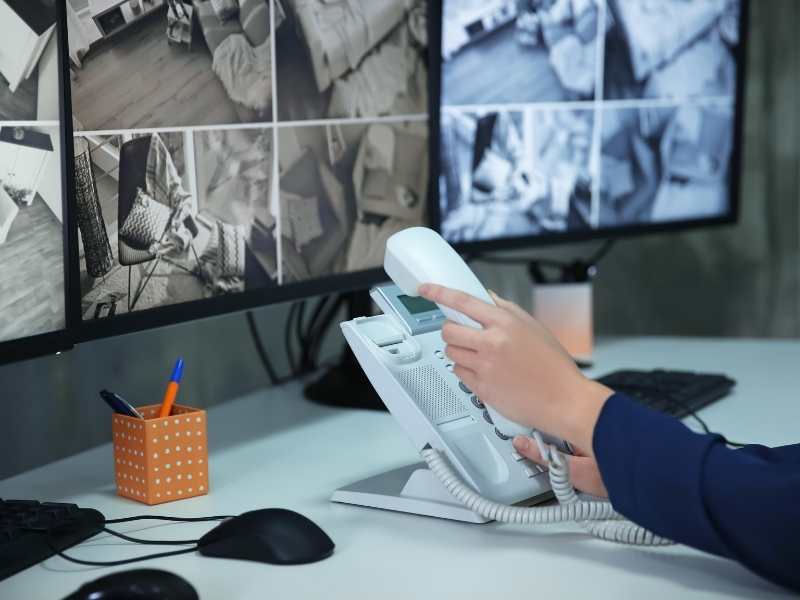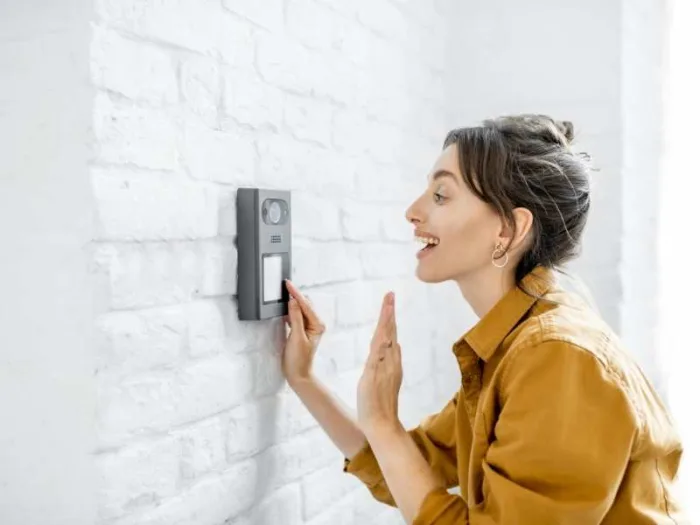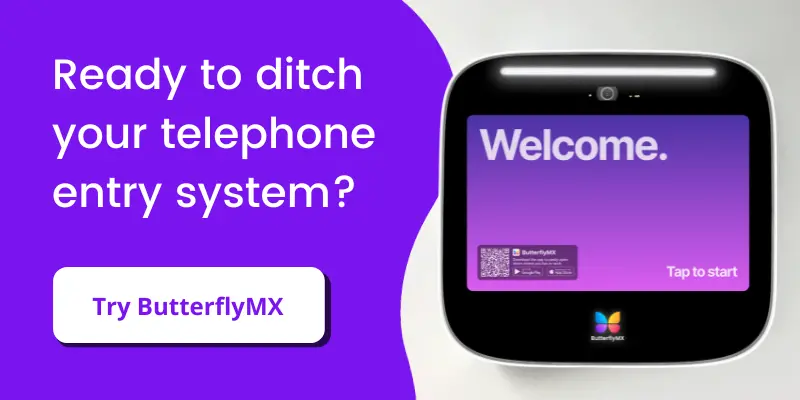Key takeaways
- A telephone entry system with a camera allows residents to both talk to visitors and see who they are talking to.
- The main difference between video intercoms and telephone entry systems is that video intercoms offer more security options and convenient alternatives when residents wish to communicate with guests and let them into the building.

If you own or manage a property – whether residential or commercial – you know that every building needs a property access system. But how do you verify a visitor’s identity before providing them with building access? Installing a telephone entry system with a camera is one option.
In this post, we’ll review what a telephone entry system with a camera is. Next, we’ll review how a telephone entry system with a camera works. Finally, we’ll compare a telephone entry system with a camera to a video intercom system and determine which one is better.
This post covers:
- What is a telephone entry system with a camera?
- How do telephone entry systems with cameras work?
- Limitations of telephone entry systems with camera
- Telephone entry systems with cameras vs. video intercom systems
- Why a video intercom access control system is better
What is a telephone entry system with a camera?
A telephone entry system with a camera is an electronic device that enables communication and property access between residents and visitors. Starting in the 1980s, telephone intercom manufacturers started offering systems with cameras. The camera can either be purchased and installed separately or built into the entry system.
Unlike traditional telephone door entry systems, those with cameras allow the residents to see the visitor either on an in-unit screen or from their smartphones. Of course, it’s only in recent years that the majority of people started owning smartphones. So, most telephone entry systems with cameras are only compatible with in-unit hardware.
Many telephone entry systems operate via a traditional telephone line with plain old telephone service and require hardware installed at the property’s entryway and a telephone to receive calls. If the system includes in-unit hardware, residents can view video footage and communicate with visitors through those devices.
Cellular telephone entry systems work similarly to telephone entry systems. If the entry system is mobile app-based, residents view video footage from their smartphones and press a button to grant visitor access. A cellular telephone entry system is often just referred to as a telephone entry system or tele entry system.
Phone entry systems with video are usually installed at gates or doors to allow tenants and authorized visitors access.
You may find this type of entry system installed at:
- Gated community main entrances
- Student housing entrances
- Senior/assisted living communities’ doors
- Hospital building entries
- Multifamily apartment building entry doors
- Commercial building entrances
- Retail building doors
The origins of video telephone intercoms
For over a century, telephone entry systems have been the most popular access control system. Soon after Alexander Graham Bell invented the telephone, entry phone systems became the standard by the early 1900s. And by the 1980s, after electronic cameras emerged in 1975, these entry systems came with cameras, adding an extra layer of security to property access.
Although deemed controversial, security cameras (CCTV) invented and used in World War II may have inspired the idea to include cameras on telephone entry systems. The U.S. was relatively slow to adopt video intercom systems, especially since families rarely felt the need to even lock the front door. However, soon after the war ended, Americans became more sensitive to security needs.
How do telephone entry systems with cameras work?
When a visitor or a delivery person needs access to a building, they look up the tenant using the telephone entry system’s directory. When the visitor finds the tenant, they press a button or dial a code. Then, the camera turns on, and the entry system calls the resident’s registered phone number.
When a tenant receives a call, their in-unit device shows them video footage of the visitor. The resident and the visitor can talk to each other, but only the resident can see the visitor. Since the entryway hardware lacks a screen, the visitor cannot see the resident. If the resident wants to grant access, they press ‘9’ – or a marked ‘open’ button – to unlock the door or gate for the visitor.
Residents must register their landline or mobile phone number for the whole system to work. Plus, most telephone entry systems with cameras also require indoor hardware to be installed.
Telephone entry with a camera requires five components:
- Outdoor hardware with a camera installed at the front door or gate. Some cameras are motion-sensor, while others turn on once a visitor initiates the call.
- In-unit display screens on which residents can see the video footage of a visitor.
- A door release system that unlocks the door when the resident presses ‘9’ on their phone or a designated button.
- Power supply.
- Telephone wiring and/or cellular connection.
2 types of telephone entry systems with cameras
One thing’s for sure: Technology has advanced significantly since the 80s. Since the invention of camera cell phones at the turn of the century, the world has forever changed its views on the purpose of video recording. And the advent of smartphones further accelerated the use of video in everyday life. Although telephone entry systems with cameras were initially designed to be used with landlines and in-unit hardware, some newer models are compatible with smartphones.
The two types of telephone entry with a camera are:
- Landline systems. A landline telephone entry system can either operate with in-unit hardware or the tenant’s own landline telephone. In-unit devices for landline telephone entry systems with cameras come with a display screen and a telephone or dialing pad. Another way these systems work is to use a computer as a monitor and a separate landline phone to talk to the visitor.
- Cellular systems. Many camera telephone entry systems are accompanied by cellular connection boxes to enable users to control access with their smartphones. However, those cellular telephone entry system connection boxes are an added cost and don’t work with all telephone entry systems.

Limitations of telephone entry systems with cameras
Although camera-enabled telephone entry systems are indeed an upgrade from older models, they still have limitations.
Here are three significant drawbacks of telephone entry systems with cameras:
- They require a telephone line. This means they can’t connect wirelessly and need a costly telephone line. Even if your residents connect their cell phones to the entry system, long-distance call fees will apply.
- Not cloud- or internet-based. Telephone entry systems only offer one-way video, which means only residents can see live video footage. This is because anything more would be too large for telephone lines to carry. Because the system is not connected to the internet, property staff can’t manage or update the directory remotely.
- No video capabilities. Telephone entry systems with cameras can’t transmit video data to both parties. Residents can see visitors, but visitors can’t see residents. Also, there is no way to record and save video trails – a top security feature – on a phone-based entry system.
Telephone entry systems with cameras vs. video intercom systems
Telephone entry systems with cameras are outdated – at most, they’re a humble effort to modernize a worn system. Meanwhile, video intercom systems are specifically designed for modern living. They enhance security and convenience for both residents and property staff.
Why a video intercom access control system is better
We’re not living in the 1980s anymore. So, it’s time to upgrade your building’s entry system to suit the new digital age. Today, people do everything on their smartphones – start car engines, order food delivery, shop for groceries, turn on and off lights, cash checks, and so much more.
ButterflyMX’s video intercom makes property access simple, convenient, and more secure than ever before.
The ButterflyMX Video intercom features:
- Cloud-based software that updates automatically, removing the need for maintenance.
- 156° wide-angle camera that offers video coverage of your entire entryway, allowing users to see who they’re talking to.
- Date- and time-stamped entry events are recorded and stored in the cloud every time someone tries to gain access to the building.
- A mobile app that allows for keyless entry. Users can enter just by tapping the ButterflyMX app on their phone.
- Remote access is available so that residents can let guests and visitors in without having to physically be present to buzz them into the property when they request entry.
- Front desk station software empowers you to view a live video feed of your property’s intercoms, speak directly to your visitors, and authenticate guest access credentials by sharing live video with residents.
- ButterflyMX ecosystem encompasses a wide range of access control products that work in tandem, allowing you to secure your entire property from a single platform.







